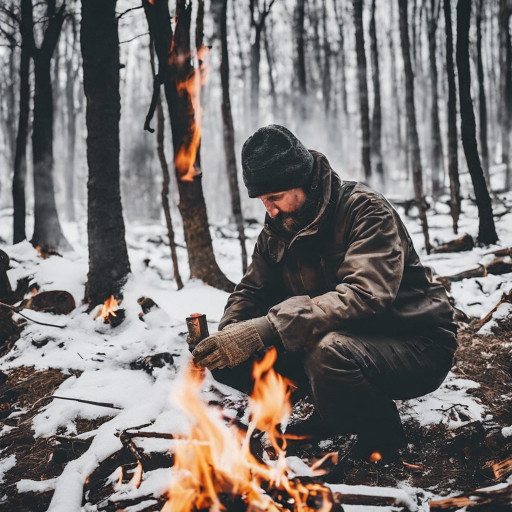Essential Fire Starting Techniques for Surviving Extreme Cold Conditions
Mastering the skill of starting a fire in frigid temperatures is not just an advantageous ability; it is an absolute necessity for survival in unforgiving winter scenarios, where the cold can be biting and relentless. For those who are committed to survivalism, the significance of a fire cannot be overstated. It is vital for retaining body heat, providing essential light, and enabling you to cook food safely. However, the process of igniting flames in icy environments comes with distinct challenges that require targeted techniques and strategies. In this in-depth guide, we will explore the most effective methods for successfully starting fires in cold weather, equipping you with the vital knowledge and skills needed to navigate the harshness of winter and thrive in the wilderness.
Prepare Your Fire Starting Kit: Essential Gear for Winter Survival
Before embarking on your winter wilderness adventures, it is imperative to equip yourself with the right gear and supplies that can significantly enhance your survival odds. A meticulously prepared fire-starting kit can make the difference between warmth and peril in extreme conditions. Be sure your kit contains these vital items:

a. Firestarters: Dependable tools such as waterproof matches, storm-resistant lighters, and fire-starting rods are essential for ensuring ignition, even in challenging conditions marked by wind and moisture. Having multiple reliable options gives you the confidence to start a fire, no matter what obstacles you may encounter in the wild.
b. Dry Tinder: Locating dry tinder in sub-zero temperatures can be particularly daunting. To tackle this challenge effectively, pack highly flammable materials like birch bark, fatwood shavings, and cotton balls soaked in petroleum jelly. These items ignite rapidly and significantly increase your chances of successfully starting a fire when temperatures plummet below freezing.
c. Kindling: To establish a solid foundation for your fire, collect dry sticks, twigs, and small branches. Ensure these materials are completely dry, as any moisture can hinder the ignition process and lead to frustration when trying to spark a flame. Properly prepared kindling is essential for transitioning from tinder to a more substantial fire.
d. Fuel: Securing dry firewood in cold weather can be both challenging and time-consuming. Therefore, having a sufficient supply of dry firewood readily available is crucial for maintaining a steady fire over an extended period. This preparation enables you to stay warm and comfortably prepare food while minimizing the risk of running out of fuel.
Choosing the Best Fire Location: Strategies for Maximum Efficiency and Safety
When the temperature drops, selecting an optimal location for your fire can provide significant advantages. Seek out sheltered spots, such as rock formations or dense shrubbery, to reduce exposure to biting winds. By positioning your fire near a natural windbreak, you not only minimize heat loss but also enhance the likelihood of maintaining a steady flame. Additionally, consider constructing a small wind-resistant shelter using logs or a tarp to shield the fire from precipitation and help retain warmth, ultimately improving your comfort and safety while enjoying the great outdoors.
Master Layering Techniques for Building a Sustainable Fire: Create Long-Lasting Flames
One of the most crucial techniques to successfully ignite a fire in cold conditions is mastering the art of layering your materials effectively. To build a fire that burns consistently, you must utilize three foundational layers: tinder, kindling, and fuel. Here’s a detailed breakdown of each layer and its critical significance:
a. Tinder: The first layer, known as tinder, consists of materials that ignite rapidly and easily. Use fine, dry substances such as grass, paper, or the aforementioned birch bark to ensure a robust initial flame. It's vital to have an ample quantity of tinder ready to achieve successful ignition, especially in frigid environments where conditions are far from ideal.
b. Kindling: This layer comprises small sticks and twigs that ignite quickly and generate sustained heat. Gradually add kindling to your flame, ensuring enough space between pieces to promote airflow and encourage efficient combustion. This step is crucial for transitioning from small, flickering flames to a larger, more stable fire that can provide the warmth you need.
c. Fuel: Once a steady flame has been established, introduce larger pieces of firewood gradually. Ensure that the wood is dry, as it will burn longer and produce more heat. Increase the size of the wood pieces progressively, allowing the flames to grow stronger before adding larger logs. This strategic approach to layering your fire facilitates a stable and sustainable flame, essential for your overall success.
The layering technique creates a structured setup that allows the flames to expand and sustain themselves effectively. Always ensure you have an adequate supply of each component readily available to facilitate a smooth transition from tinder to fuel, thereby ensuring a successful fire in challenging conditions.
Boost Your Fire Starting Success with Proven Aids and Techniques: Improve Your Odds
In extremely cold weather, employing additional fire-starting aids can significantly elevate your chances of successfully igniting a fire despite the challenges posed by low temperatures. Here are some highly effective methods to consider:
a. Fatwood: Often referred to as nature’s firestarter, fatwood is resin-infused pine wood that ignites easily and burns with intense heat. You can gather these naturally occurring sticks from fallen pine trees or purchase them from outdoor supply stores. A few pieces of fatwood can dramatically enhance your chances of successfully starting a fire in exceedingly cold conditions, acting as a reliable ignition source.
b. Alcohol-Based Hand Sanitizer: Surprisingly effective, alcohol-based hand sanitizer is highly flammable and can function as a potent accelerant. Applying a small amount to your tinder or kindling can help ignite a fire quickly, even in damp conditions. This handy addition simplifies the fire-starting process and ensures you stay warm when it matters most, making it a valuable tool in your kit.
c. Char Cloth: Char cloth is specially prepared fabric that ignites easily from sparks, making it an excellent tool for starting fires using flint and steel or a lighter in challenging situations. Its lightweight and portable nature make it an ideal addition to your fire-starting kit, ensuring you are always prepared to face the unexpected.
Incorporating these fire-starting aids into your cold-weather toolkit can significantly boost your chances of success when facing particularly challenging conditions, enabling you to adapt effectively to your environment and ensure your safety.
Explore Innovative Fire Techniques Tailored for Cold Weather Conditions
As a dedicated survivalist, continually refining your skills is essential for your success in the wilderness. Here are two fire techniques that excel in cold weather conditions, providing warmth and efficiency:
a. Swedish Torch: Also known as a Canadian Candle or Finnish Fire Log, the Swedish Torch is an extraordinarily effective fire-starting method. This technique provides a stable and long-lasting flame, making it ideal for combating winter chills. To create a Swedish Torch, find a log about knee-height and cut several vertical slits along its length. Place tinder in these slits and ignite it. The log will serve as a consistent fuel source, allowing the flame to endure for an extended period, ensuring warmth and safety during your outdoor adventures.
b. Dakota Fire Hole: In the face of strong winds, the Dakota Fire Hole method proves exceptionally effective. This technique involves digging a hole and tunneling horizontally underground to create an airflow vent. This design harnesses wind to enhance airflow, resulting in a more efficient fire that is less likely to be disrupted by gusts. Additionally, the Dakota Fire Hole method effectively reduces visible smoke while conserving fuel, making it an excellent choice for discreet fire building and ensuring you remain unobtrusive in the wild.
Regardless of the fire-starting method you choose, always prioritize safety and responsible fire management to minimize risks and ensure a successful fire-starting experience. Being mindful of your surroundings and adhering to local regulations will enhance your overall experience.
Successfully igniting a fire in cold weather necessitates meticulous planning and execution. By following these steps—preparing a reliable fire-starting kit, selecting an appropriate location, mastering layering techniques, utilizing fire-starting aids, and employing specific fire strategies—you will significantly boost your chances of success in the wilderness. Remember, practice is key, so consistently train to refine your skills and enhance your confidence. With these essential tactics for igniting fires in freezing conditions in your toolkit, you'll be well-prepared to face even the harshest winters nature has to offer. Stay warm, prioritize your safety, and keep the flames of survival alive!
The post Fire Starting Methods for Survivalists in Cold Weather appeared first on Survival Bite.
The Article Fire Starting Techniques for Cold Weather Survival Was Found On https://limitsofstrategy.com
The Article Cold Weather Survival: Essential Fire Starting Techniques First Appeared ON
: https://ad4sc.com


This post certainly highlights a crucial aspect of winter survival that often gets overlooked in discussions about outdoor skills. The importance of fire in cold conditions not only pertains to warmth but extends to psychological well-being, creating a sense of security and comfort when faced with the isolation of the wilderness. The ritual of building a fire can also provide a mental anchor, something to focus on amidst the harsh environment.
It’s fascinating to think about how crucial fire-making is, especially in extreme cold conditions. I remember my first time camping in winter—what an eye-opener that was! I packed all my usual gear, but I seriously underestimated how difficult it would be to start a fire with frozen fingers and damp wood. The reality of it hit hard when I found myself huddled in my sleeping bag, shivering and wishing I had practiced more before getting out there.